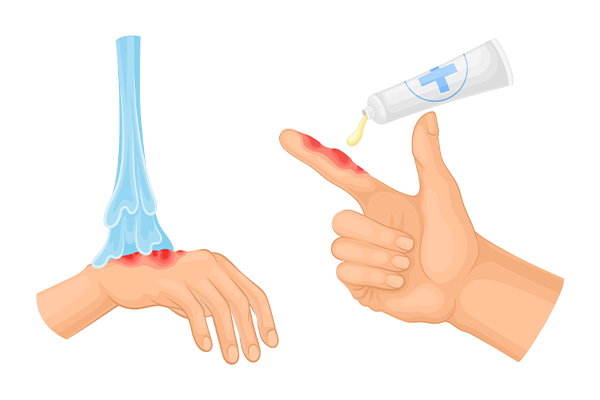
A sizzling skillet, a splash of hot tea, or a careless afternoon in the sun — any of these can result in a painful burn. Even the smallest skin burn requires timely and proper skin burn treatment to prevent infection, reduce scarring, and promote fast healing.
In this guide, we’ll explain what to do immediately after a burn injury, how to treat it at home, how to heal burned skin, and how to remove burn marks from skin once the wound has closed. You’ll also learn when to seek medical help and how Manipal Hospital Patiala can assist you in recovery with expert skin burn treatment.
Synopsis
- Types of Burns and Typical Reasons
- Skin burns frequently result from
- What to Do Immediately After a Skin Burn
- Things to Do and Not Do Following a Skin Burn
- Methods for Healing Burns
- How to Eliminate Skin Burn Marks
- When to Get Medical Assistance Right Away
- Effects on the Mind and Emotions
- Conclusion
Types of Burns and Typical Reasons
Understanding the type and cause of a burn is essential for choosing the right skin burn treatment.
First-Degree Burns
Affect only the outer layer of skin, causing redness, mild swelling, and discomfort (like a sunburn).
Second-Degree Burns
Penetrate deeper into the skin, often causing blisters, more intense pain, and swelling.
Third-Degree Burns
Severely damage all skin layers, potentially affecting nerves and underlying tissues. The area may look white, leathery, or charred. These burns require immediate hospital care and advanced skin burn treatment.
More Reads: How to Perform CPR: Guidelines, Procedure, & Methods

Skin burns frequently result from
-
Heat-related burns: Steam, hot liquids, or flames
-
Chemical burns: Caused by acids, bleach, or home cleansers
-
Electric shock or defective wiring can cause electrical burns.
-
Radiation burns: Resulting from extended exposure to sunlight
Time is of the essence following a burn. By doing these actions, you may shield your skin and lessen any long-term consequences.
More Reads: 7 Tips to Take Care of Dry Skin | Skincare Guide
What to Do Immediately After a Skin Burn
Time is crucial when treating burns. Follow these essential steps for proper skin burn treatment.
1. Put an immediate stop to the burn
Apply cool, but not ice-cold, tap water to the afflicted region for ten to twenty minutes. This calms the skin and halts the burning process. Avoid using ice, as it might exacerbate the harm.
2. Get Rid of Restricted Things
Remove any tight clothes, bracelets, or rings that are close to the burned region before the swelling starts. If anything is stuck, don't try pulling it.
3. Shield the Burn
The region should be gently wrapped with sterile gauze or a clean, non-stick dressing. Infection is less likely as a result. Steer clear of anything fluffy, like cotton wool.
4. Don't Touch Blisters
Avoid popping blisters if they appear. It's how your body defends the wound. Cover it after carefully cleaning it with water and mild soap if it breaks naturally.
5. Reduce Pain
For pain, take paracetamol as advised by the doctor. Observe dosing guidelines at all times. if pain worsens or persists, consult a doctor promptly for further skin burn treatment.
6. Maintain Skin Hydration
Apply aloe vera gel or a fragrance-free moisturiser as soon as the skin begins to heal to maintain the area supple and less tight. Avoid products with alcohol or strong fragrances. This will help in your goal of how to heal burned skin safely.
More Reads: Dermatitis: Triggers, Symptoms, and Tips to Soothe the Skin
Things to Do and Not Do Following a Skin Burn
Do -
-
Keep it covered and clean.
-
Consume over-the-counter painkillers.
-
Keep an eye out for infection symptoms.
-
Use water to cool the area.
-
Follow a recommended skin burn treatment plan
Avoid -
-
Remove any blisters.
-
using butter, toothpaste, or ice.
-
Massage the region.
-
Ignore a huge or worsening burn.
Methods for Healing Burns
The severity and location of skin burns determine how quickly they recover. Here are some tips on how to heal burned skin and support recovery.
-
Consume a diet rich in nutrients, including leafy greens, protein, vitamin C, and zinc.
-
Be sure to keep things tidy: Gently use a light soap to cleanse the area.
-
Steer clear of picking: Scratching or peeling scabs leads to further scarring.
-
Sunscreen with an SPF of 30 or higher is recommended for new skin since it is extremely sensitive.
Regular moisturising is also part of effective skin burn treatment, promoting elasticity and reducing dryness.
More Reads: Understanding Sunburn: Causes, Symptoms, and Remedies
How to Eliminate Skin Burn Marks
Even small burns might result in pigmentation and scarring later. Others may persist, while others fade spontaneously. Here's how to remove burn marks from skin safely and gradually.
1. Apply Creams or Sheets with a Silicone Basis
Dermatologists advise them for softening elevated skin, eliminating pigmentation, and decreasing scar thickness.
2. Use of natural oils (after the wound has healed)
Vitamin E, rosehip oil, and aloe vera can all help improve the suppleness and tone of the skin. But never apply them to exposed wounds without first doing a patch test.
3. Sun Protection
Sunlight can make burn scars darker. Applying sunscreen helps to heal burned skin and prevents darkening of scars.
4. Treatments for Dermatology
If DIY solutions don't work, think about getting help from a professional like:
-
Laser treatment
-
Peels made of chemicals
-
The use of microneedling
For advanced care on how to remove burn marks from skin, consult our dermatology expert at Manipal Hospital Patiala, offering a full range of cosmetic skin treatments
When to Get Medical Assistance Right Away
It's not always safe to treat burns at home. If the burn is bigger than your palm, visit our hospital.
-
Some portions are burned, black, or white.
-
The burn is on the genitalia, hands, feet, or face.
-
Blisters might be big or contain a murky substance.
-
Infection symptoms include pus, a bad odour, fever, and increasing discomfort.
-
Burns, even minor ones, should always be treated by a doctor if the patient is young, old, or has a medical condition like diabetes.
Children, older adults, or people with diabetes should always consult a doctor for any skin burn treatment.
At Manipal Hospital Patiala, our specialists offer complete care from wound dressing to long-term solutions for how to heal burned skin and reduce scarring.
Effects on the Mind and Emotions
Burns are not limited to the skin. Scars can impact one's confidence and emotional well-being, particularly if they are visible. Feeling self-conscious or nervous is OK. It might be beneficial to attend a support group or speak with a therapist. Being kind to oneself while you heal is another aspect of healing.
Reasons to Follow Up and Be Mindful
The healing process continues even after the discomfort subsides. Consistent follow-ups can -
-
Find hidden infections.
-
Track the formation of scars.
-
Give tailored guidance on skin repair.
-
Under one roof, Manipal Hospital Patiala provides comprehensive post-burn care, including bandages, cosmetic scar treatments, and psychological assistance.
Conclusion
Burns require careful attention, whether they are caused by a tiny cooking accident or a terrible sunburn. Less scarring and faster healing can result from understanding what to do and acting quickly. Remind yourself not to disregard it. Cool, cover, take care of, and seek advice if necessary.
Trust the skilled staff at Manipal Hospital Patiala for quick and efficient skin burn treatment if you or a loved one sustains a burn. Our knowledgeable staff is here to support your safe internal and external healing.
FAQ's
No. It can irritate and damage the skin further.
Minor marks may fade in weeks, but deeper ones can take several months.
Yes, if used on clean, closed wounds. It cools, hydrates, and soothes the skin.
No. Let it burst naturally, if at all. Popping it can cause infection.
Silicone-based creams or sheets are clinically proven to reduce scarring. Consult our experienced dermatologists in Patiala to know the best creams that can be applied on the wound and the painkillers that can help in case of severe pain.





















 7 Min Read
7 Min Read









.png)





